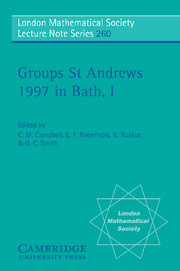Book contents
- Frontmatter
- Contents
- Contents of Volume II
- Introduction
- Radical rings and products of groups
- Homogeneous integral table algebras of degrees two, three and four with a faithful element
- A polynomial-time theory of black box groups I
- Totally and mutually permutable products of finite groups
- Ends and algebraic directions of pseudogroups
- On locally nilpotent groups with the minimal condition on centralizers
- Infinite groups in projective and symplectic geometry
- Non-positive curvature in group theory
- Group-theoretic applications of non-commutative toric geometry
- Theorems of Kegel-Wielandt type
- Singly generated radicals associated with varieties of groups
- The word problem in groups of cohomological dimension
- Polycyclic-by-finite groups: from affine to polynomial structures
- On groups with rank restrictions on subgroups
- On distances of multiplication tables of groups
- The Dade conjecture for the McLaughlin group
- Automorphism groups of certain non-quasiprimitive almost simple graphs
- Subgroups of the upper-triangular matrix group with maximal derived length and a minimal number of generators
- On p-pronormal subgroups of finite p-soluble groups
- On the system of defining relations and the Schur multiplier of periodic groups generated by finite automata
- On the dimension of groups acting on buildings
- Dade's conjecture for the simple Higman-Sims group
- On the F*-theorem
- Covering numbers for groups
- Characterizing subnormally closed formations
- Symmetric words in a free nilpotent group of class 5
- A non-residually finite square of finite groups
Characterizing subnormally closed formations
Published online by Cambridge University Press: 05 August 2013
- Frontmatter
- Contents
- Contents of Volume II
- Introduction
- Radical rings and products of groups
- Homogeneous integral table algebras of degrees two, three and four with a faithful element
- A polynomial-time theory of black box groups I
- Totally and mutually permutable products of finite groups
- Ends and algebraic directions of pseudogroups
- On locally nilpotent groups with the minimal condition on centralizers
- Infinite groups in projective and symplectic geometry
- Non-positive curvature in group theory
- Group-theoretic applications of non-commutative toric geometry
- Theorems of Kegel-Wielandt type
- Singly generated radicals associated with varieties of groups
- The word problem in groups of cohomological dimension
- Polycyclic-by-finite groups: from affine to polynomial structures
- On groups with rank restrictions on subgroups
- On distances of multiplication tables of groups
- The Dade conjecture for the McLaughlin group
- Automorphism groups of certain non-quasiprimitive almost simple graphs
- Subgroups of the upper-triangular matrix group with maximal derived length and a minimal number of generators
- On p-pronormal subgroups of finite p-soluble groups
- On the system of defining relations and the Schur multiplier of periodic groups generated by finite automata
- On the dimension of groups acting on buildings
- Dade's conjecture for the simple Higman-Sims group
- On the F*-theorem
- Covering numbers for groups
- Characterizing subnormally closed formations
- Symmetric words in a free nilpotent group of class 5
- A non-residually finite square of finite groups
Summary
Introduction
All groups considered in this paper are finite.
In Zur Theorie der endlichen aüflosbaren Gruppen [10] Gaschütz defined a formation as a class of groups ℱwith the following properties:
1) every homomorphic image of an ℱ–group is an ℱ–group.
2) If G/M and G/N are ℱ-groups then G/M ∩ N is an ℱ-group.
In [10] a formation ℱ is said to be saturated if the group G belongs to ℱ whenever G/Φ(G) is in ℱ. In the universe of finite solvable groups the definition of a saturated formation provided a context in which to study extensions of the properties of Carter subgroups to classes other than the nilpotent groups. The importance of saturated formations and their relationship to ℱ -covering subgroups is well known. Zur Theorie der endlichen auflösbaren Gruppen also provided the spur for other developments in finite group theory. In [10] Gaschütz proved that if ℱ is a saturated formation that contains the nilpotent groups, then ℱ has the following property:
For H ⊴ G, if H/H ∩ Φ(G) belongs to ℱ then H belongs to ℱ.
Note that any formation ℱ that has the property (*) must necessarily be saturated and contain all groups of prime order.
- Type
- Chapter
- Information
- Groups St Andrews 1997 in Bath , pp. 356 - 362Publisher: Cambridge University PressPrint publication year: 1999



